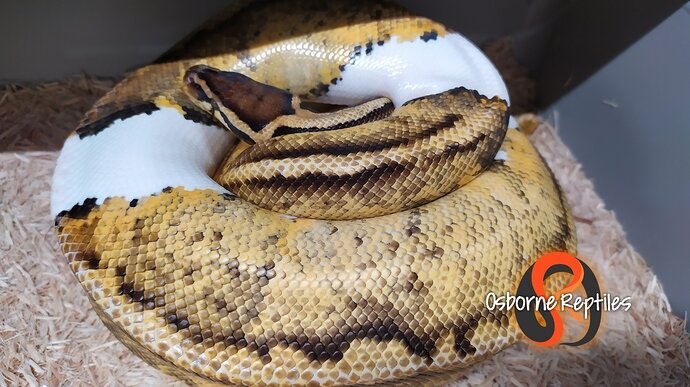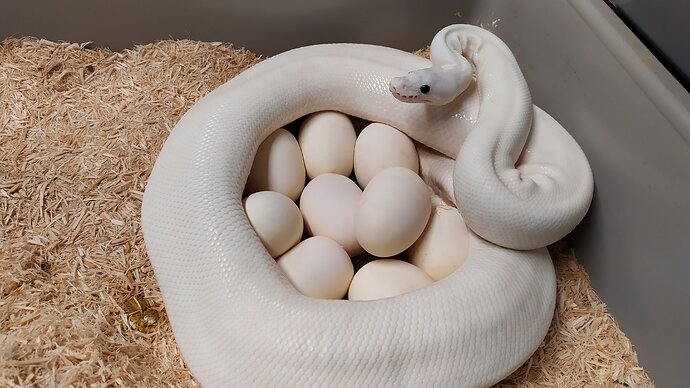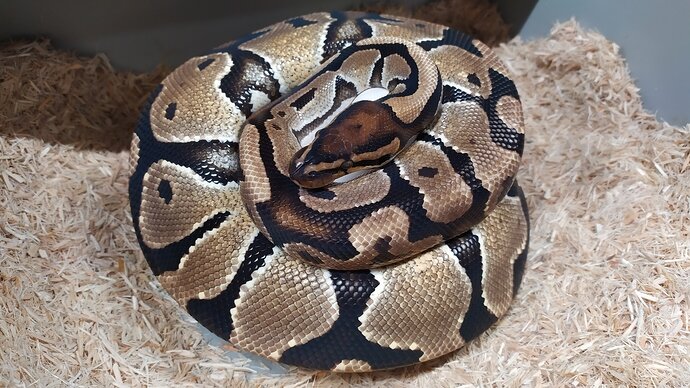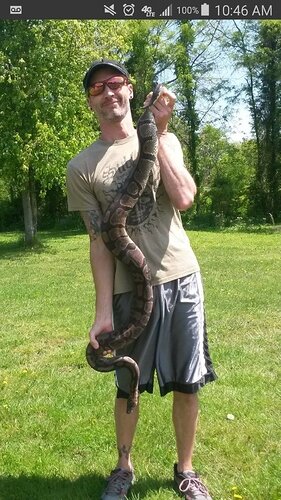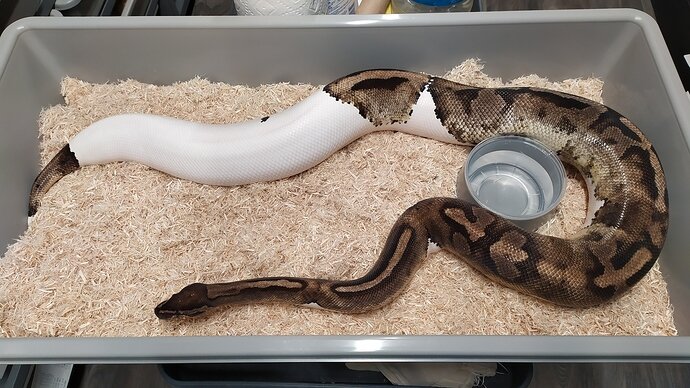I’ve noticed a few times where someone in a video is pulling a female off of 3-4 eggs and they seem to be around 1000 grams or so. They don’t look very long nor do they appear to have been significantly large. I’ve been offered proven breeders that have laid recently and they state they had 4 eggs. I ask for the current weight of the female and get no answer at all. Is it common to breed females early? Is it an issue long term? Is it something breeders do then unload the females after the first season? Are they breeding all their females like that or just the ones they need for one season?
Females bred early or underweight give lower number of eggs and higher number of slugs as far as I know. I have heard that when this is done it also causes that female to lay small clutches the rest of her life. The female being pulled from a clutch of eggs is going to be smaller looking because she just laid those eggs (not saying they were proper weight to begin with) I dont know how others breed their animals so I cannot answer your question pertaining to what others do, but they should not be bred that way.
As far as I know, the female laying the eggs if bred early does not cause the babies to have small clutches. I could be wrong because I dont have experience or research myself on this being an issue, so hopefully someone who knows for sure can clear that up for the both of us.
I spoke with a guy who mentioned the 1000 gram wall being something to get over with breeding. I’m hesitant to agree with something like that. Maybe someone with more experience could chime in,. I think it’s a taboo subject.
Size of the hatchling itself could definitely be swayed by the laying female being bred too early in my opinion.
I know a guy that did that with a 5 year old female. She was 1100. He tried the male trick as a last resort. He was with her just one day. She ate a couple of rats. Then laid 8 eggs down the road. She’s still in that 1000 range. That’s a different situation I find acceptable. But breeding females at 1000 and are young still I think is irresponsible. What I don’t personally know is , what do they do in the wild ??
It’s probably best to accept a practice of not buying anything under a certain weight to combat this? Say 150 grams for example?
150 grams would be an established hatchling already having several successful feedings, they are not hatched at that size. It would not guarantee it wasnt layed by under weight female but would guarantee that the animal is eating successfully already. I dont think there is anyway of avoiding or knowing an animal was produced by poor breeding practices by the weight of hatchling for sale unless it was severely small.
what @unkn0vvn1221 said
I personally have not seen a hatchling come out of the egg at over 100 grams. Though I have seen the more eggs the female lays, the smaller those can be, but they grow to be normal size and it doesn’t affect their clutches.
Nice questions @doodle,
In most cases follicular development is completely dependent on room , adjacent room as they stagger themselves from eachother -therefore follicle count is directly proportionate to length… 15 years ago it was staple practice/ethical practice to wait until 2500grams to breed a female… contrary to that having worked with all different genotypes from various locations of Africa some females will never attain 2500grams… shoot there are even plausible dwarf lines that some experienced breeders are working with… with this in mind… a girl will procreate when environmental conditions are correct and her body allows… even without fertilized ovum! A habit of offering breeder females at 1000 Grams IMO is unethical and implies (based on my egg formular) a 1500gr Female before egg deposition… but that is just me, I like them big and I grow my boys stout as well. I’ve had eggs from small girls I’ve had them from big girls but in all my years the low end of a healthy procreating Female before dropping eggs is 1800grams (I don’t have any dwarfs) and 2250-4000 is way more common here , 5500 high end producing 1750g of eggs, 1800 low end producing 600 grams of viable eggs… as far as your other questions you are on the right path to deciding what kind of keeper you are… keep up the good work
@wickedfairymagic You say you grow your males up large too? That’s something contrary to what I’ve heard around from multiple sources. I’ve heard That. " Large males are lazy males and won’t breed well". I have no males at this point just ladies, been hesitant to get any males just yet
I remember 20 years ago when I started the topic was about 1000-1200g as a starting point. Obviously it’s been updated to 1500. In my opinion you cannot tell a female snake when to mature and develop follicles. I have had females refuse food for 4-6 months outside of a cooling period. Turned out they had huge follicles and wanted to mate. They were between 1100-1300 grams. So I bred them and got 4-6 egg clutches with normal sized babies.
The most important thing for a breeder of snakes is to know your animals, know how to read them, and how to care for them. Just because they may seem under size does not mean they cannot reproduce.
Now I’m not saying go out and start breeding early. I’m saying raise your snakes to start breeding at 1500+ grams BUT if they tell you through experienced methods that they want to breed. Then breed them and see what happens.
FYI I’ve had 3000 gram females retain the follicles and not produce cause they just stopped and didn’t want to!
I would assume that the contrary part averages to a lot of keepers stating they like their males at around1000 grams… and I would contend that this may fit into a lot of trend breeders plans who may make a yearly investment on the next new thing to amp up their production results or those that might be replaced by the next years offspring…which in essence might move a male breeder out of their colony before reaching 3-4 years old after siring that one or two seasons of dames… boys are just like girls in that their adult size is affected by genotype as well as how they are grown… I for sure have bred males at less than a year of age as small as 300 grams with success and have had eggs on the ground from them before that calendar 1st year birthday at 500grams but it’s way more common in my colony to start a new male with trial pairings at 750 grams at a year of age for them to have sired eggs by the time they are 18months… back to genotype - on my low end of healthy adult proven males is About 1250grams covering the genes that I have worked through the years (they all get there with time without being lazy(I don’t have dwarf lines)), but within my colony (again built by imports and as close as I can get to founding animals of associated stock morphs) it is more typical for them to sit at 1500-1750 high end and 1500 while actively breeding. My most powerful breeders that sire my most prolific and large girls or girls comparable in size actively breed at 1500-1750 grams and idle out during long breaks (if they have one at ~1750g). It’s common for one of my males at that size to have trial breedings with a girl coming to age at the same weight for her to inturn mass up to 2500g’s before deposition. I do live in Florida and typically breed year round and it is this type of male that can actively, safely breed a large harim of girls, stay on feed and never skip a beat… I rarely have to stop a breeding program because a male is off feed and nearly never need to stop a male because he needs more mass in his last third musculature And I keep very strict guidelines. Never have had a lazy male, I either have had males that don’t breed because they haven’t come to age, breed but don’t sire or Rico suave males or Mike Tyson males…
@duckdangerfield having a colony of females is the best you can do, it’s all about the girls, they make the eggs… 18 months is a good stagger point to work from with decent success -2 years gives you more cushion for a male to come online (again a 6 month old can sire your girls but 18months may be the most typical for males to have offspring hit the ground) They are all different and just like girls are ready when they are ready… there are a lot of tactics to push them but that questions what your intentions are, if you know what they are there are safe and unsafe practices… it may be important to you to get a boy siring by a specific time of the year so you can move him out and replace him or if you aren’t in a rush and have longer term goals you might keep him much longer… I Currently still actively pair an 06 male import patriarch over here! As well I have teenage and in their 20’s females laying clutches amongst my colony of 2-4 year old first time girls And teenagers approaching their double digit clutch.
100% agreeance with @sickpyth7 girls in this species are ready by feel of the experienced keeper… and his statement goes hand in hand with the old saying (given husbandry is on point)
‘If their not feed-un… breed-um!’
That doesn’t mean you should breed everything when they are ready unless that is the goal you set… you will and can have good success in holding off a girls virginity for more weight and length gains resulting in a larger higher number clutch first time through… and as for the egg set question up there… it can be somewhat true but typically if you continue with a female into double digit years and you feed them appropriately through these years they will continue to grow in their first couple decades which can warrant gains in length essentially giving more room for the extra follicle…
case in point from a clutch that hit the ground here last weekend from a 12 year old … age 3 at 2500grams 6 eggs, add 5% gains yearly… laid 6, then 6, then break, then 7,then 8, then 8 , then 8 then break , then 10, 135gram eggs at 4750 grams
I have a 21 year old that laid 10 at age 6, then 11 for many years, then in 2014 she laid a bakers dozen and has laid the bakers 13 since… she’s had a couple years off and is looking loaded… and I can’t even count them… she may Most definitely have 14 this summer… a little time will tell.
I’ve been breeding balls since 1993. Back then the recommended weight for females was 1000g minimum, and this was the standard for the BIG breeders at the time. This 1500g rule did not change until about 15 years ago, and even more recently I’ve seen 1800-2000g.
The fact is, Reptiles are instinctive animals and can’t tell how old they are or what weight they are. They rely on survival instinct alone. Old or young age has nothing to do with their reproduction. It is entirely about condition.
I’ve bred many many females under the age of two and my smallest clutch has been 6 eggs. I had one female last year lay 10 eggs, which hatched 1 month and 1day before her second birthday. I’ve also had animals I’ve raised for 4 years that were bred around 1200g and produce nice size clutches.
From a breeder standpoint, most people don’t feed their females enough to ever see massive clutches like some of us see. I feed no more than one meal a week but tend to feed a little larger than most. I often get 10 egg clutches from first time females under 3 years old. Most go on to average 8-12 eggs per clutch.
As far as hatchling weight goes, average is around 65g but my Bertha line Pieds will sometimes average 90g out of the egg with a few over the years that have popped out at 120g. Once they’ve eaten 3-5 solid meals they’re ready to go to new homes.
I’m not saying do what I do. It works for me but may not be the right choice for you. Just my experience.
First timer this year under 3 years old. 8 eggs
First time female under 3 years old. 11 eggs
First time under 2 years old. 8 eggs
My oldest female will be 18 this fall. Her first clutch of 9 eggs was lay when she was 2 years 5 months old. Her last clutch in 2018 was 19 eggs and weighed just under 2000g. Her lifetime average has been 13.8 eggs per clutch and she’s been the most prolific breeder I’ve had, but her daughters and granddaughters are gaining on her. This pic is from 3 years ago.
One of her much smaller daughters in an ARS 70 tub.
Whoa! She’s huge, how much does she weigh? Is she an import?
I really appreciate your insight on this. I appreciate that you took The time to answer what I feel is legitimate questions and give your experiences here. It really does show that there is more than one way to succeed and that maybe some people are doing the bare minimum. Thanks for your time and I’ll apply these strategies personally!
